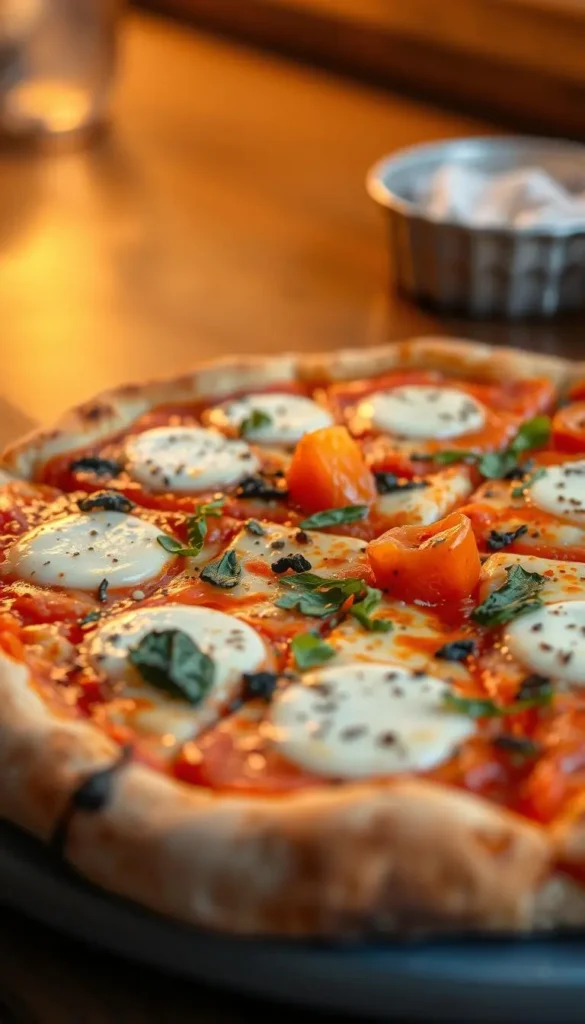There’s something special about biting into a perfectly cooked Neapolitan-style pizza. It has a delicate crust and flavorful toppings. Making authentic pizzas at home is a labor of love for me. It’s about recreating the magic of your favorite Italian restaurants in your own kitchen.
In this article, I’ll guide you through making delicious homemade pizzas. We’ll explore the history of Italian Pizza and the essential equipment you need. You’ll also learn about the key ingredients that give it that authentic flavor.
You’ll discover various regional Italian Pizza specialties. And, you’ll learn how to create your own signature pizzas.
Key Takeaways
- Learn the history and origins of authentic Italian Pizza
- Discover the essential equipment needed for homemade pizza making
- Understand the key ingredients that give Italian Pizza its authentic flavor
- Explore various regional Italian Pizza specialties
- Create your own signature pizzas with confidence
The Art and History of Italian Pizza
Exploring Italian pizza, I find its history and regional styles fascinating. This dish has become a global favorite, rooted deeply in Italian tradition.
Origins of Pizza in Italy
Pizza started in Naples, Italy, in the late 18th or early 19th century. Before, flatbreads were cooked in wood-fired ovens and topped with various ingredients. Raffaele Esposito, a Neapolitan baker, made a pizza for Queen Margherita in 1889. It had tomato sauce, mozzarella, and basil, earning it the name “Pizza Margherita.”
Regional Pizza Variations Across Italy
Italy has many regional pizza styles, each unique. From the thin Neapolitan crusts to the thick Sicilian sfincione, the choices are endless.
| Region | Pizza Style | Characteristics |
|---|---|---|
| Campania | Neapolitan | Thin crust, soft center, fresh toppings |
| Sicily | Sfincione | Thick crust, rich toppings, often served with anchovies or sausage |
| Rome | Roman | Thin crust, crispy, often topped with simple ingredients like olive oil and rosemary |
These regional styles show the diversity of Italian pizza. They also highlight the value of local ingredients and traditional cooking.
Essential Equipment for Authentic Italian Pizza
To make authentic Italian pizzas at home, you need the right tools. The quality and taste of your pizzas depend on the equipment you use.
Pizza Stones and Steel
A pizza stone or steel is key for a perfect crust. They soak up moisture from the dough, making the crust crispy. Preheat your stone or steel in the oven at 500°F (260°C) for at least an hour before baking.

Proper Mixing and Measuring Tools
Getting the measurements right is vital for great pizza dough. A digital scale is a must for precise ingredient measurements. A stand mixer with a dough hook can also help, but it’s not required.
Oven Considerations
A wood-fired oven is perfect for authentic Italian pizzas, but it’s not necessary for home cooks. A domestic oven, preheated with a stone or steel, can also make excellent pizzas. Make sure your oven can reach high temperatures and adjust cooking time as needed.
| Equipment | Purpose | Recommendation |
|---|---|---|
| Pizza Stone/Steel (by on amazon) | Crispy Crust | Preheat at 500°F (260°C) |
| Digital Scale | Accurate Measurements | Essential for ingredient measurement |
| Stand Mixer (by on amazon) | Dough Mixing | Simplifies dough preparation |
Investing in the right equipment can make a big difference in your pizza-making skills. It brings the authentic taste of Italy right to your home.
Key Ingredients for Traditional Italian Pizza Recipes
The foundation of a great Italian pizza is its ingredients. I’m here to guide you through the essentials. The quality and type of ingredients you choose greatly impact the flavor and texture of your pizza.
Flour Types and Their Importance
The type of flour used is key for the perfect dough. Italian pizzas often use “00” flour, also known as Caputo flour. It’s finely ground and has low protein content. This flour makes a tender crust that’s both crispy and chewy.
Other flours, like all-purpose or bread flour, can change the crust’s texture. They might make it different from the traditional Italian pizza crust.
The Right Tomatoes for Authentic Sauce
San Marzano tomatoes are the gold standard for Italian pizza sauce. They are sweeter and less acidic than other tomatoes. This makes them perfect for a rich and tangy sauce.
When picking tomatoes, look for those labeled “San Marzano.” Make sure they are certified by the European Union for authenticity.
Choosing Quality Cheese and Toppings
Mozzarella di Bufala is the traditional cheese for Italian pizzas. It’s made from water buffalo milk and has a creamy texture. This cheese melts beautifully.
For toppings, keep it simple with fresh ingredients. Use basil, oregano, and prosciutto. The goal is to balance flavors without overloading the pizza.
| Ingredient | Description | Importance |
|---|---|---|
| “00” Flour | Finely ground flour with low protein content | Crucial for tender crust |
| San Marzano Tomatoes | Sweet and less acidic tomatoes | Essential for authentic sauce |
| Mozzarella di Bufala | Cheese made from water buffalo milk | Traditional cheese for Italian pizzas |
By focusing on these key ingredients, you can make authentic Italian pizzas at home. Remember, the quality of your ingredients affects the flavor and texture of your pizzas. Choose wisely.
Classic Neapolitan Pizza Dough Recipe
Making a real Neapolitan pizza starts with a simple dough recipe. You need flour, water, salt, and yeast. The quality of these ingredients and how you make the dough are key to a great crust.
Complete Ingredient List
To make a classic Neapolitan pizza dough, you will need:
- 1 kg of Type “00” flour (or Caputo flour)
- 625 ml of water
- 10 g of salt
- 1 g of active dry yeast (such as Baker’s yeast)
The flour you use is very important. Type “00” flour, also known as Caputo flour, is best for its fine texture. Using the right flour is essential for an authentic Neapolitan pizza.
Step-by-Step Mixing and Kneading Process
To mix and knead the dough, follow these steps:
- In a large mixing bowl, combine the flour and salt.
- In a separate container, dissolve the yeast in the water.
- Gradually add the yeast mixture to the flour, mixing until a dough forms.
- Knead the dough on a floured surface for about 10 minutes, until it becomes smooth and elastic.
Kneading is a critical step that develops the gluten in the dough, giving the crust its characteristic chewiness. After kneading, form the dough into a ball and let it rest.
Proper Fermentation and Proofing Techniques
The fermentation and proofing process is vital for developing the flavor and texture of the crust. Place the dough ball in a lightly oiled bowl, cover it with plastic wrap or a damp cloth, and let it ferment in a warm, draft-free place.
The dough should be allowed to ferment for at least 12 hours, or overnight, at room temperature. After the initial fermentation, the dough should be divided into smaller balls, or “dough balls,” and allowed to proof for another 1-2 hours before shaping.
Proper fermentation and proofing are key to achieving a light, airy crust with a slightly charred edge, characteristic of a traditional Neapolitan pizza.
Authentic Italian Pizza Recipes to Master at Home
Bringing Italy to your kitchen is easier than you think with these authentic Italian pizza recipes. Making pizza at home can be a fun and rewarding experience. This is true when you follow traditional methods and ingredient lists.
Pizza Margherita Recipe
Pizza Margherita is a classic Neapolitan-style pizza. It shows the simplicity and flavor of Italian cuisine.
Ingredients
- 1 1/2 cups warm water
- 1 tablespoon active dry yeast
- 3 1/2 cups all-purpose flour
- 1 teaspoon salt
- 1 tablespoon extra-virgin olive oil
- 1/2 cup San Marzano tomatoes, crushed
- 8 ounces fresh mozzarella, sliced
- Fresh basil leaves
Preparation Steps
- Combine warm water and yeast, letting it sit for 5-10 minutes.
- Mix flour, salt, and olive oil to form a dough.
- Knead the dough for 10 minutes until smooth.
- Let the dough rise for 1-2 hours.
- Shape the dough into a ball and flatten into a disk.
- Top with crushed tomatoes, mozzarella slices, and basil.
- Bake in a preheated oven at 500°F (260°C) for 10-12 minutes.
Pizza Marinara Recipe
Pizza Marinara is another traditional Neapolitan pizza. It’s known for its simplicity and rich flavors.
Ingredients
- Same dough ingredients as Pizza Margherita
- 1/2 cup San Marzano tomatoes, crushed
- 4-6 anchovy fillets
- 2 cloves garlic, minced
- Olive oil
- Fresh oregano leaves
Preparation Steps
- Follow the same dough preparation as Pizza Margherita.
- Top the dough with crushed tomatoes, anchovy fillets, and garlic.
- Drizzle with olive oil and sprinkle with oregano.
- Bake in a preheated oven at 500°F (260°C) for 10-12 minutes.
Pizza Quattro Formaggi Recipe
Pizza Quattro Formaggi is a rich and creamy pizza. It combines four different cheeses.
Ingredients
- Same dough ingredients as Pizza Margherita
- 1/2 cup Gorgonzola cheese, crumbled
- 1/2 cup Parmesan cheese, grated
- 1/2 cup Mozzarella cheese, sliced
- 1/4 cup Ricotta cheese
- Fresh thyme leaves
Preparation Steps
- Prepare the dough as in Pizza Margherita.
- Top the dough with Gorgonzola, Parmesan, Mozzarella, and dollops of Ricotta.
- Sprinkle with thyme and bake in a preheated oven at 425°F (220°C) for 12-15 minutes.
| Pizza Recipe | Main Ingredients | Baking Temperature | Baking Time |
|---|---|---|---|
| Pizza Margherita | Tomatoes, Mozzarella, Basil | 500°F (260°C) | 10-12 minutes |
| Pizza Marinara | Tomatoes, Anchovy, Garlic | 500°F (260°C) | 10-12 minutes |
| Pizza Quattro Formaggi | Gorgonzola, Parmesan, Mozzarella, Ricotta | 425°F (220°C) | 12-15 minutes |
Mastering these authentic Italian pizza recipes at home brings Italy’s flavors to your table. It also connects you with the rich culinary traditions of this beloved cuisine.
Regional Italian Pizza Specialties
Italy’s pizza scene is a world of flavors and traditions. Each area has its own pizza style. This is shaped by local ingredients, cultural influences, and history.
Sicilian Sfincione Recipe
Sicilian Sfincione is a thick, square pizza from Palermo, Sicily. It’s known for its rich toppings like anchovies, sausage, and cheese.
Ingredients
- 1 cup of strong flour
- 1/2 cup of semolina flour
- 1/2 cup of water
- 1/4 teaspoon of active dry yeast
- Salt to taste
- Olive oil for greasing
- Anchovies, sausage, and a blend of cheeses for topping
Preparation Steps
- Combine the flours and water to form a dough, letting it rise for several hours.
- Preheat the oven to 400°F (200°C).
- Shape the dough into a square and top with anchovies, sausage, and cheese.
- Bake until the crust is golden and the toppings are bubbly.
Roman Pizza al Taglio Recipe
Roman Pizza al Taglio is a rectangular pizza cut into squares. It’s famous for its crispy crust and varied toppings.
Ingredients
- 2 cups of all-purpose flour
- 1 cup of water
- 1/4 teaspoon of salt
- 1/4 teaspoon of sugar
- Olive oil for greasing
- Various toppings such as prosciutto, mushrooms, and rosemary
Preparation Steps
- Mix the dough ingredients and let it rise until doubled in size.
- Preheat the oven to 425°F (220°C).
- Shape the dough into a rectangle, top with desired ingredients, and bake until crispy.
- Cut into squares and serve.
| Pizza Style | Crust Type | Typical Toppings |
|---|---|---|
| Sicilian Sfincione | Thick, square-cut | Anchovies, sausage, cheese |
| Roman Pizza al Taglio | Crispy, rectangular | Prosciutto, mushrooms, rosemary |
| Tuscan Schiacciata | Thin, dimpled | Olive oil, rosemary, salt |
Tuscan Schiacciata Recipe
Tuscan Schiacciata is a thin, dimpled flatbread. It’s topped with olive oil, rosemary, and salt. This pizza style is simple yet flavorful, from Tuscany.
Ingredients
- 2 cups of all-purpose flour
- 1 cup of water
- 1/4 teaspoon of salt
- Olive oil for greasing and topping
- Rosemary leaves for topping
Preparation Steps
- Mix the dough ingredients and let it rest for a few hours.
- Preheat the oven to 400°F (200°C).
- Shape the dough into a thin sheet, dimple with fingers, and top with olive oil, rosemary, and salt.
- Bake until lightly golden.
These regional Italian pizzas show the diversity and richness of Italian food. By trying these recipes, you can bring Italy’s flavors home.
Perfecting Your Pizza-Making Technique
Learning to make pizza is a journey. It involves understanding how to prepare the dough, spread toppings, and bake it. To make authentic Italian pizzas, you need to master a few key skills.
Stretching the Dough Like a Pro
Stretching pizza dough is an art that needs a gentle touch and practice. To get a perfectly rounded crust, start by pressing down on the dough. Then, stretch it outward from the center. Avoid overworking the dough, as it can make the crust tough.
Proper Topping Distribution
For a well-balanced pizza, spread toppings evenly. Start with a thin layer of sauce, then sprinkle cheese, and add your toppings. Remember, less is often more with toppings, as too many can make the crust soggy.
Baking Temperature and Timing
Baking temperature and timing are key for a perfectly cooked crust. For a wood-fired effect, bake at a high temperature (around 500°F) for 10-12 minutes. Use the following table as a guide:
| Baking Temperature (°F) | Baking Time (minutes) | Crust Characteristics |
|---|---|---|
| 450 | 15-18 | Soft, chewy crust |
| 500 | 10-12 | Crisp, well-done crust |
| 550 | 8-10 | Charred, crispy crust |
By mastering these techniques and trying different temperatures and toppings, you’ll make delicious Italian Pizza Recipes. They’ll be as good as your favorite pizzeria’s.
Serving and Pairing Your Italian Pizza
Make your Italian pizza nights special with the right serving and drinks. Serving pizza is more than just putting it on the table. It’s about making a moment that feels like Italy.
Traditional Italian Accompaniments
Start with traditional sides that go well with your pizza. A simple green salad with a light vinaigrette is a great choice. You can also try grilled or roasted veggies like zucchini or eggplant, seasoned with olive oil, garlic, and herbs.
Popular Italian Sides:
- Bruschetta: toasted bread rubbed with garlic and topped with diced tomatoes and basil
- Caprese salad: a simple salad of sliced tomatoes, mozzarella, and basil, dressed with olive oil
- Fried arancini: stuffed rice balls that are fried until crispy
Wine and Beverage Pairings
Wine is a classic choice for pairing with Italian pizza. For a Neapolitan-style pizza, a dry white wine like Pinot Grigio works well. For pizzas with more cheese, a medium-bodied red wine like Chianti is a good match.
| Pizza Type | Recommended Wine | Alternative Beverage |
|---|---|---|
| Neapolitan | Pinot Grigio | Peroni Beer |
| Quattro Formaggi | Chianti | San Pellegrino |
| Marinara | Vermentino | Iced Tea with Lemon |
Presentation Tips for Authentic Experience
The way you present your pizza can make a big difference. Serve it on a wooden pizza peel or a round pizza board, just like in Italy. Add fresh basil leaves and a drizzle of extra virgin olive oil for extra flavor.
By focusing on these details, you can bring a real Italian pizza experience to your home. Your family and friends will love the delicious food and the cozy atmosphere.
Conclusion: Bringing Italy to Your Kitchen
Our journey through Italian pizza has ended, but the real magic is just beginning. By mastering traditional recipes and techniques, you can bring Italy’s flavors to your kitchen.
Quality ingredients are key. Use the right flour and San Marzano tomatoes for an authentic taste. Don’t forget the right tools like pizza stones and steel for the perfect crust. With time and effort, your pizzas will be as good as those in Italy.
Now, it’s your turn to try different recipes and toppings. Make a classic Pizza Margherita or try Sicilian Sfincione. As you get better, you’ll love sharing your delicious pizzas with loved ones.


